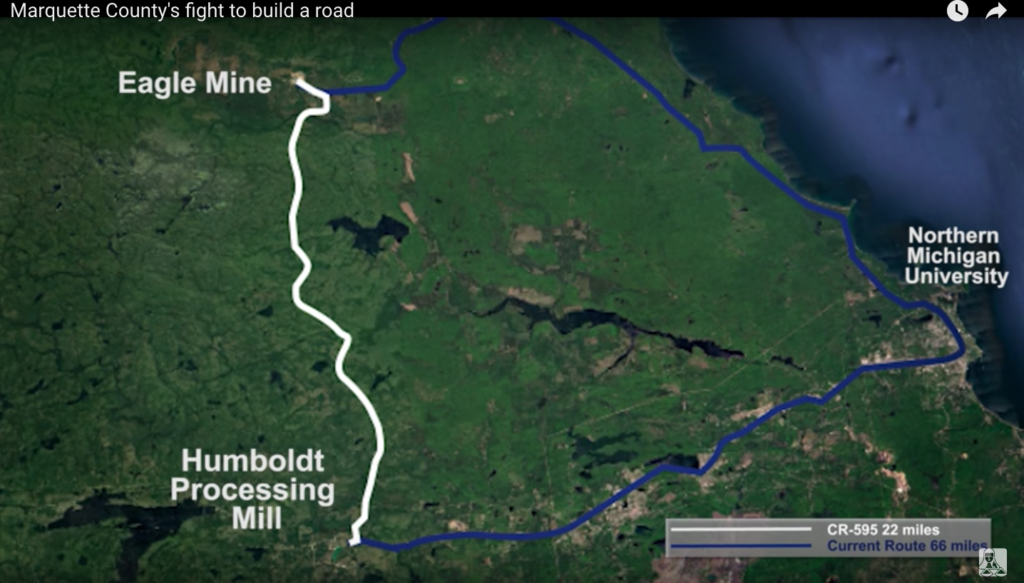PLF Michigan road project case gets attention from the WSJ

Blue = current dangerous truck route. White = safe CR 595 plan.
Saturday’s Wall Street Journal will include a Pacific Legal Foundation op-ed co-authored with Mike Pattwell, an environmental litigator at Clark Hill. The op-ed addresses PLF‘s Marquette County Road Commission v. EPA case, where PLF and Clark Hill represent a local government as it takes on the leviathan federal government and its Environmental Protection Agency.
PLF doesn’t normally represent the government, but here this local government may as well be David taking on Goliath. Our fans know that PLF specializes in David v. Goliath cases. The Journal op-ed sets out why the case will affect the path of the law:
The project has its roots in a “eureka” moment eight years ago. A large deposit of nickel and copper was discovered in the state’s Upper Peninsula at what is now known as the Eagle Mine. This presented Marquette County with a new economic opportunity, but also a dilemma. The mine is only 22 miles from the nearest refinery as the crow flies, but the trip is nearly three times as long via existing roads. The usual route would send processions of heavy, noisy trucks through commercial and residential areas in small towns, as well as along the edge of campus at Northern Michigan University.
The proposed solution was to construct a new county road, a direct path from the mine to the mill. That would allow the trucks to bypass busy city streets and groggy college students.
State and local officials in both parties broadly support the project, since they see it as critical for the community’s safety and environmental health.
***
The problem is the federal permits. In 2012, the state’s Department of Environmental Quality announced it intended to approve the new road, which complied with all federal and state laws. That’s when the Obama administration stomped in.
The project required a wetland-fill permit, which the EPA vetoed in December 2012 with a vague warning about dangers to the environment. Agency officials have never provided the kind of details that would allow their putative concerns to be objectively assessed, but they have stuck to their objections tenaciously.
Frustrated by Washington’s continued inflexibility, the Marquette County Road Commission, which we represent, appealed to the courts in 2015, asking a judge to determine whether the EPA was correct to scuttle the project. But the EPA contended that its veto was immune from judicial review. Last spring a Michigan federal court bought that argument.
***
This might have been the end of the trail. But shortly thereafter the Supreme Court issued a landmark ruling that punctured the bureaucrats’ pretensions. In U.S. Army Corps of Engineers v. Hawkes (2016), the justices unanimously held that when federal regulators label property as “wetlands,” the affected parties have an immediate right to challenge that designation in court. Following the logic of Hawkes, the road commission has now brought its case against the EPA to the Sixth U.S. Circuit Court of Appeals.
The irony is that the EPA is blocking a project that would be environmentally beneficial. “When trucks can travel 22 miles one way rather than 50-plus miles one way, that’s a savings of almost 500,000 gallons of fuel annually,” Jim Iwanicki, the engineer for the county road commission, told Marquette’s legal team last fall. “On top of that savings of fossil fuel, County Road 595 would significantly reduce the amount of carbon dioxide those trucks are putting out, since they’d be driving 1.5 million miles less a year.”
The public-safety arguments are even more compelling. “Those trucks come barreling down the street and are turning right next to campus,” Eli Groupille, a student at Northern Michigan University, said in an interview about the case. “The trucks weigh 164,000 pounds, and when students cross the road sometimes they don’t understand it can be hard to quickly slow those trucks down.”
It is scandalous that the federal bureaucracy can arbitrarily thwart such a valuable state-approved project—and then insist it needn’t answer for its decisions
With the case set for mediation on Monday, the Wall Street Journal could not have picked a more opportune time to let us explain why the EPA should reverse its stance and permit the road project that everyone in Michigan but the most foolhardy want approved. To learn a little more about the case, I encourage you to watch this video that explains why this lawsuit matters to so many in the Upper Peninsula of Michigan:
We will report back next week regarding whether the EPA has come to its senses.



